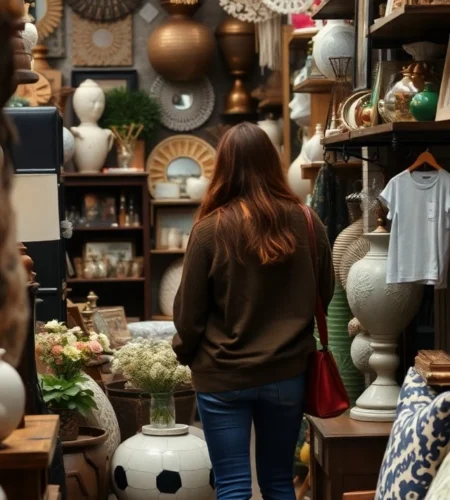Your walls feel bare, your furniture looks like it came from a college dorm clearance sale, and your bank account is giving you the side-eye every time you browse West Elm. What I discovered during my third year of solo apartment living— cheap home decor ideas aren’t just about saving money; they’re about creating a space that tells your unique story without the designer price tag.
Table of Contents
The Complete Solution: Cheap Home Decor Ideas for Under $200
Cost Range: $50-200 total room makeover
Time Investment: 2-4 weekends
Difficulty Level: 2/5 (beginner-friendly)
Core Implementation Steps:
- Start with thrift store treasure hunting – Focus on picture frames, vases, and small furniture pieces
- Create a cohesive color palette using spray paint and fabric to unify mismatched finds
- Layer textures and lighting through affordable textiles and DIY lamp makeovers
- Maximize vertical space with wall-mounted storage that doubles as decor
Professional consultation recommended for major furniture modifications or electrical work.
Why Thrifting Became My Decorating Superpower
I learned that 72% of people feel more true to themselves and authentic when they can express who they are via the layout and style of their homes or workplaces. The secret isn’t just about finding cheap items—it’s about developing an eye for potential.
I’ve furnished and decorated 85% of my space through thrifted finds, spending less than $800 total over three years. My biggest revelation? The most expensive-looking pieces in my home cost under $15 each.
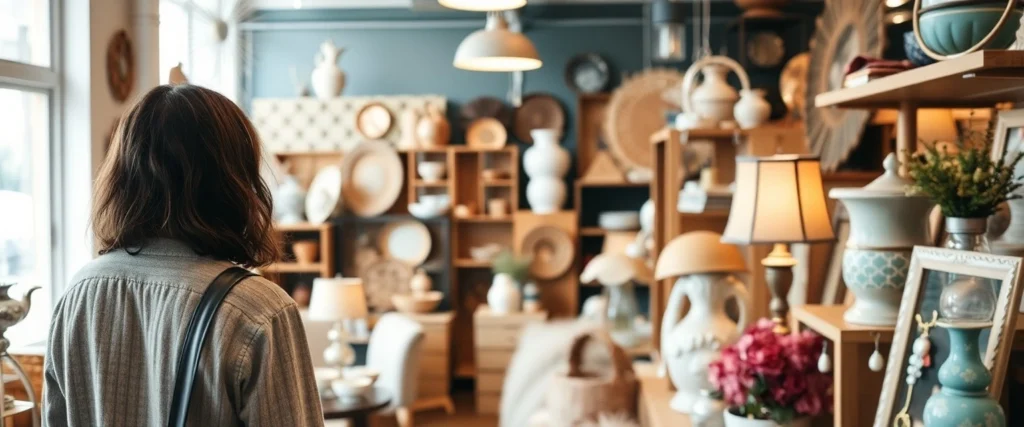
The Thrift Store Treasure Map: What to Hunt For
Furniture Gold Mines ($5-50 per piece)
Dressers and Side Tables
These are your biggest bang-for-buck investments. Look for solid wood construction—you can always paint over scratches and dings. I once scored a mid-century dresser for $25 that would retail for $400 new. A weekend with sandpaper and sage green paint transformed it into my bedroom’s statement piece.
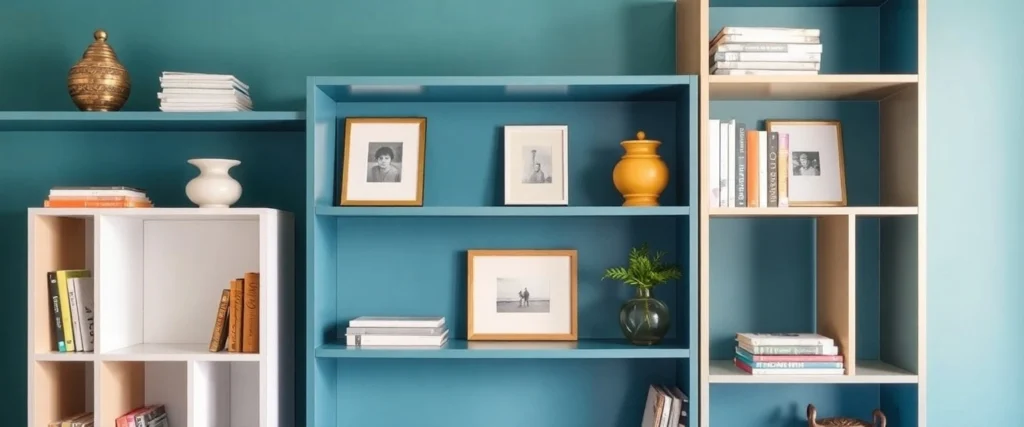
Bookshelves and Storage Units
Perfect for creating room dividers in studio apartments. Add peel-and-stick wallpaper to the back panels for an instant upgrade.
Pro tip: Mismatched shelving units painted in the same color family create an intentional, curated look that guests assume was professionally designed.
Dining Sets and Chairs
Don’t worry about matching—embrace the eclectic vibe. Paint all chairs in coordinating colors from the same palette. I found four different chair styles for $8 each and painted them in varying shades of dusty blue. Guests always ask where I found my “designer” dining set.
Decor Essentials ($1-15 per item)
Picture Frames
The ultimate thrift store hack—frames often cost less than $1 each. Buy artwork just for the frames if needed, then create your own gallery wall with free printables or personal photos.
Vases and Containers
Glass vases are abundant at thrift stores and perfect for transformation. A $2 clear vase becomes a $30-looking piece with gold spray paint. I use thrifted bowls and dishes as decorative storage throughout my apartment—keys by the door, hair ties in the bathroom, loose change on my dresser.
Lamps and Lighting
Focus on the base structure rather than the shade. Lamp shades are inexpensive to replace, but a good ceramic or metal base can anchor an entire room’s aesthetic. My favorite find was a brass table lamp for $8 that I paired with a $12 linen shade.
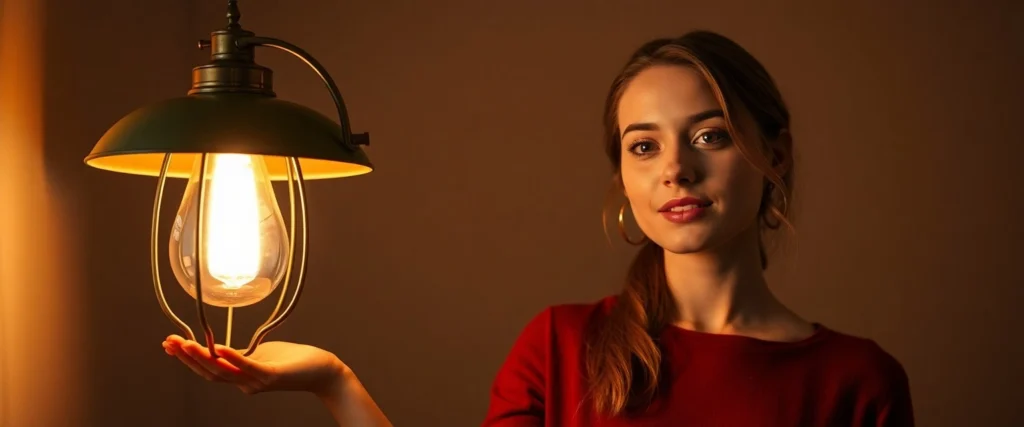
Textiles and Soft Furnishings
Curtains, throw pillows, and blankets add instant coziness. Look for natural fabrics that can be easily washed and refreshed. Even if the pattern isn’t perfect, solid-colored textiles in your chosen palette will elevate any space.
The Art of Transformation: DIY Magic on a Dime
Paint: Your $15 Room Makeover Tool
Spray paint is the ultimate equalizer in home decor. I keep gold, matte black, and white spray paint on hand at all times. Here’s my foolproof transformation process:
- Clean thoroughly – Use degreasing dish soap for the best paint adhesion
- Prime if needed – Especially important for glossy surfaces
- Apply thin, even coats – Multiple light coats beat one heavy application
- Seal with clear coat – For high-touch items like drawer pulls
Pro Tip: Create a “spray paint station” in your garage or balcony with a cardboard backdrop. I’ve transformed everything from picture frames to plant pots in assembly-line fashion, saving hours of setup time.
Fabric and Reupholstery Basics
Don’t let reupholstery intimidate you. Start small with dining chair seats or throw pillows. I learned by watching YouTube tutorials and practicing on a $3 thrift store stool. The key is choosing forgiving fabrics—canvas and linen hide imperfections better than silk.
My Beginner-Friendly Reupholstery Kit:
- Heavy-duty staple gun
- Fabric scissors
- Seam ripper
- Measuring tape
- Extra batting for cushioning
Hardware Upgrades That Make Everything Look Custom
Swapping out drawer pulls, cabinet knobs, and furniture legs is like jewelry for furniture. I buy hardware in bulk online—brass pulls cost $2 each versus $8 at home improvement stores. This simple change made my $15 thrift store nightstand look like a $200 boutique piece.
Room-by-Room Budget Decorating Strategies
Living Room: The $75 Transformation
The Foundation ($40-50):
- Large area rug from Facebook Marketplace or estate sales
- Throw pillows in your color palette (mix thrifted covers with new inserts)
- One statement piece of art or a gallery wall of thrifted frames
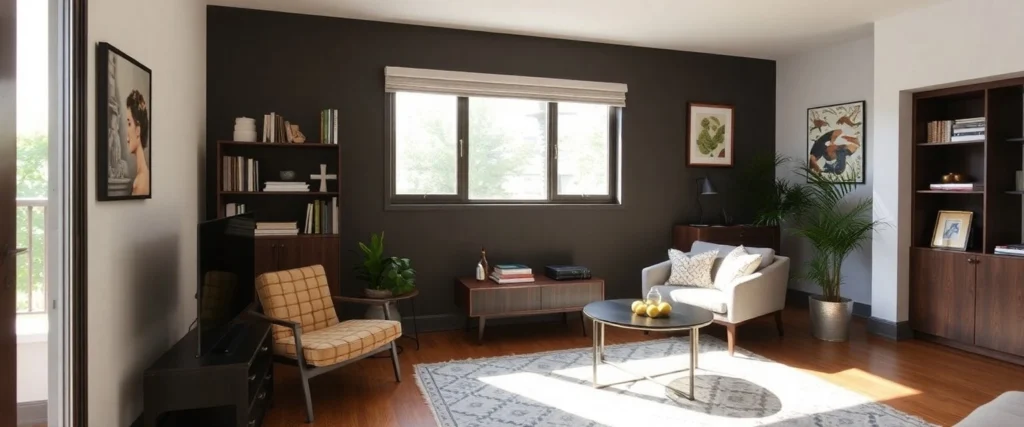
The Finishing Touches ($25-35):
- Plants in thrifted planters (snake plants and pothos are nearly indestructible)
- Candles in thrifted holders for ambient lighting
- A cozy throw blanket draped strategically
Pro Tip: Create a “coffee table” using a vintage trunk or wooden crate. It provides storage and surface space while adding character that new furniture can’t match.
Bedroom: Your $50 Sanctuary
Lighting Magic ($15-20):
Smart bulbs are game-changers for bedroom ambiance. Program them to gradually brighten in the morning and shift to warm tones at night. Pair with a thrifted lamp base for the perfect bedside lighting.
Mirror Multiplication ($20-30):
Strategically placed mirrors make small bedrooms feel twice as large. I found a full-length mirror at Goodwill for $12 and positioned it across from my window—instant light amplification and space expansion.
Textile Layering ($15-25):
Mix textures with thrifted blankets, pillows, and curtains. The key is sticking to your color palette while varying the materials—linen, cotton, wool, and faux fur all play together beautifully.
Kitchen: Function Meets Style for $40
Practical Beauty ($25-30):
Replace disposable soap dispensers with ceramic or metal ones from thrift stores. Add LED strip lighting under cabinets—it’s functional and creates a high-end look for under $20.
Display and Storage ($10-15):
Use thrifted glass jars and containers for pantry organization. They’re prettier than plastic and create a cohesive, intentional look. I found a set of six matching glass canisters for $8 that would cost $60 new.
The Psychology of Cohesive Design on a Budget
Here’s what I learned after three failed attempts at decorating my first apartment: cohesion trumps cost every time. A $5 thrift store vase painted in your signature color looks more expensive than a $50 vase that doesn’t fit your aesthetic.
My 3-2-1 Color Rule:
- 3 neutral base colors (walls, large furniture, flooring)
- 2 accent colors that appear throughout the space
- 1 pop color used sparingly for visual interest
This formula works whether your style is minimalist Scandinavian or maximalist bohemian. I stick to sage green, cream, and warm wood tones as my base, with dusty pink and brass as accents, and deep navy as my pop color.
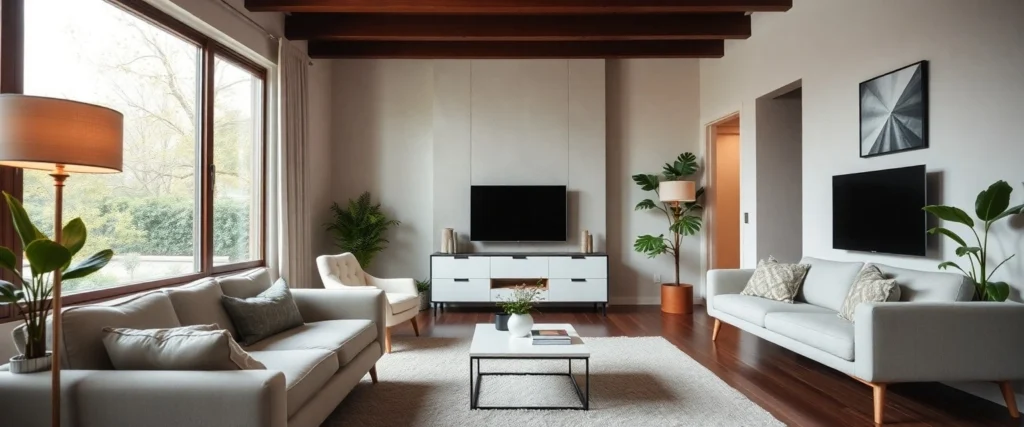
Advanced Thrifting Strategies That Changed Everything
The “Bones” Assessment
Before buying any furniture piece, I do a quick structural check:
- Drawers slide smoothly (sticky drawers usually mean warped wood)
- Joints are solid (wobbling indicates loose construction)
- Surface damage is cosmetic only (scratches paint over; structural damage doesn’t)
Timing Your Thrift Store Visits
After two years of regular thrifting, I’ve cracked the code:
- Monday mornings for weekend donation influx
- End of month for clearance sales
- Seasonal transitions for holiday decor and seasonal items
The 24-Hour Rule
If I find something I love but don’t need immediately, I wait 24 hours before buying. This prevents impulse purchases and ensures I’m only bringing home pieces that truly enhance my space.
Creating Your Personal Thrift Store Toolkit
Essential Supplies to Keep in Your Car:
- Measuring tape (for furniture and wall space)
- Phone with room photos (for color matching)
- Reusable shopping bags (for fragile items)
- Cash in small bills (for garage sales and flea markets)
- Cleaning wipes (to see past surface dirt)
My Thrift Store Shopping List Template:
- Specific measurements for spaces I’m trying to fill
- Color swatches or photos of my existing decor
- Maximum budget for the trip
- “Nice to have” versus “must have” items
Pro Tip: Take photos of your existing decor before shopping. When you’re standing in a thrift store trying to remember if that blue matches your curtains, having reference photos on your phone is invaluable.
The Ripple Effect: How Cheap Decor Improved My Entire Life
What started as a budget necessity became a creative outlet that transformed how I see my living space. When friends visit my apartment, they’re amazed by the “expensive” look I’ve achieved on a shoestring budget. But more importantly, I’ve created a space that feels authentically mine—every piece has a story, every corner reflects my personality.
The confidence I gained from successful DIY projects spilled over into other areas of my life. I started taking on bigger challenges, both in home improvement and beyond. There’s something empowering about transforming a $3 thrift store find into a $50-looking statement piece with your own hands.
Frequently Asked Questions
How do I know if a thrift store furniture piece is worth buying?
Focus on the “bones” of the piece rather than surface imperfections. Check that drawers slide smoothly, joints are solid, and any damage is purely cosmetic. Solid wood pieces are almost always worth the investment since they can be completely transformed with paint and new hardware. Avoid anything with structural damage, warped wood, or missing essential parts that would be expensive to replace.
What's the best way to create a cohesive look with mismatched thrift store finds?
The secret is establishing a consistent color palette before you start shopping. I use the 3-2-1 rule: 3 neutral base colors, 2 accent colors, and 1 pop color. Paint or recover items to fit within this palette, and suddenly mismatched pieces look intentionally curated. Also, repeat materials throughout your space—if you have brass hardware in one area, incorporate brass accents elsewhere to create visual flow.
How much should I budget for a complete room makeover using thrift store finds?
For a complete room transformation, budget $50-200 depending on the room size and your current furniture situation. Living rooms typically need $75-150, bedrooms around $50-100, and kitchens $40-80. The key is prioritizing impact pieces first—a large area rug or statement furniture piece—then filling in with smaller decorative items. Remember to factor in supplies like paint, brushes, and basic tools, which usually add $20-30 to your total budget.
What are the biggest mistakes people make when decorating on a budget?
The biggest mistake is buying items without a plan or color scheme, which leads to a chaotic, unfinished look. Another common error is focusing only on price instead of potential—passing up a $15 solid wood dresser because it needs paint, then buying a $40 particle board piece that can’t be transformed. Finally, many people underestimate the power of lighting and textiles, which are often the most affordable ways to completely change a room’s atmosphere.
How do I make small spaces look larger without spending a lot of money?
Mirrors are your best friend for creating the illusion of space, and thrift stores are full of them for under $15. Position mirrors across from windows to reflect natural light and make rooms feel twice as large. Use vertical storage solutions and mount shelves high on walls to draw the eye upward. Light colors make spaces feel more open, so consider painting an accent wall in a light, neutral tone. Finally, minimize clutter by using thrifted baskets and containers for stylish storage solutions.
Your Next 24 Hours: The Quick-Start Action Plan
Today:
- Walk through your space and identify the three areas that need the most attention
- Create a simple color palette using colors you already love
- Research thrift stores, estate sales, and Facebook Marketplace in your area
This Weekend:
- Visit two different thrift stores with your measurements and color swatches
- Pick up basic supplies: spray paint, sandpaper, and cleaning supplies
- Start with one small project—a picture frame, vase, or small decorative item
Next Month:
- Tackle one larger furniture piece or room transformation
- Share your before-and-after photos with friends (you’ll be amazed by the reactions)
- Start building your collection of go-to transformation supplies
Your apartment isn’t just a place you happen to live—it’s your personal canvas, your daily sanctuary, your creative laboratory. Every thrifted treasure you transform, every corner you thoughtfully arrange, every dollar you save while creating something beautiful is proof of your ability to craft exactly the life you want. The most stunning homes aren’t the ones with the biggest budgets; they’re the ones with the most heart, creativity, and intention. And that’s something no amount of money can buy—but a little thrift store magic can certainly help you discover it.
Use of this website constitutes acceptance of all our disclaimers and legal agreements.

